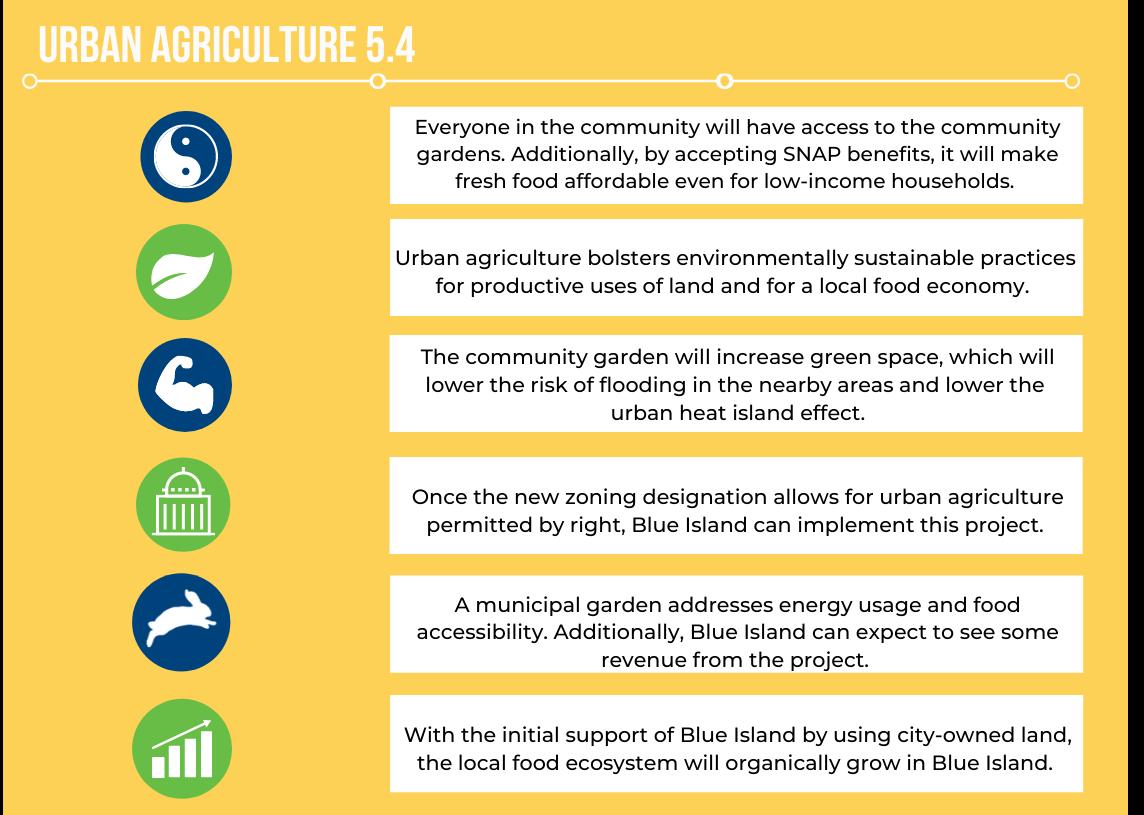
2 minute read
5.4 Urban Agriculture
Stakeholders: Blue Island Residents
Timeline: 1-5 years, 5-10 years, 10+ years
Advertisement
Urban Agriculture Urban agriculture is a practice that can contribute to a more efficient use of energy and lead to innovative methods of energy usage. In New York City, urban agriculture can reduce UHI by 22%-44% through increasing green space.66 Even though Blue Island is less dense, a similar effect can be achieved.
The majority of energy use in the food system occurs beyond the farm gate; the United Nations Food and Agriculture Organization estimates that over 75% of energy use in the food system of high-income nations occurs after cultivation.67
Therefore, localized food systems contribute to a reduction in energy usage.
Likewise, the proliferation of green space will also lower the risk of severe flooding as overall permeability throughout Blue Island will improve. Urban agriculture is particularly well suited to decrease flooding because the soil is nutrientrich and can therefore hold more moisture.68
Introducing Urban Agriculture to Blue Island
The first step that Blue Island can take is to amend the zoning code. Currently, urban agriculture is not allowed in Blue Island. Therefore, the municipal code will be amended to include a new zoning category to allow this practice (see Section 7.4).
The zoning amendments prioritizes equitable access to the benefits of urban
agriculture. The amendments allow for the creation of Community Supported Agriculture and mandates that the Illinois LINK card be accepted for food purchases.
Fostering Urban Agriculture
The Blue Island Planning Department and the Park District can work to identify vacant lots that meet the requirements for urban agriculture and utilize designated municipally owned parklands. Once a list is produced, Blue Island can work with local nonprofits to establish a network of community gardens.
This partnership will not only provide available land to these organizations but also offer support to access funding.
Fresh fruits and vegetables and a sign for the local community-supported agriculture scheme from the former Blue Island community farm, BIOS Farm.
(BIOS Farm, 2019)


Above: Growing Home farm, in Englewood, on the South Side of Chicago (Andrew Collings, 2018). Below: Chicago's Growing
Solutions Farm (Nathan Lambrecht, 2021).
Funding of urban agriculture projects
There are several federal grants that can help fund the establishment and maintenance of a municipal community garden.
The U.S. EPA has the Healthy
Communities Grant Program and Environmental Justice Small Grants Program.
The U.S. Department of Agriculture also has Grants
for Urban Agriculture and
Innovative Production for initiating and expanding gardens and for accelerating urban agriculture models.
The National Institute of Food and Agriculture provides Community Food Projects Competitive Grants for community food projects or for projects that combat food insecurity.






